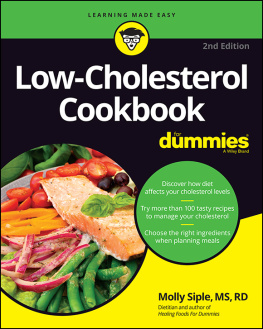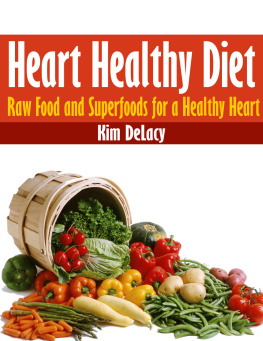
Dick Logue
Author of the best-selling 500 Low Sodium Recipes

Contents
INTRODUCTION
What Do We Mean By Heart Healthy?
F irst lets define exactly what we mean by heart-healthy recipes and how this collection is different from other cookbooks you may have or have seen. Heart-healthy diets are aimed at preventing or reducing a number of risk factors that can lead to heart attacks and heart disease. Among the more important ones are coronary artery disease, high cholesterol and high blood pressure.
The American Heart Association lists seven key items for maintaining cardiovascular health. They are:
Dont smoke
Maintain a healthy weight
Engage in regular physical activity
Eat a healthy diet
Manage blood pressure
Take charge of cholesterol
Keep blood sugar, or glucose, at healthy levels.
You can easily see that while they list diet as a separate factor, what you eat affects everything on the list except smoking and exercise. If you start digging into the details of dietary recommendations for staying a healthy weight, maintaining a healthy blood pressure and cholesterol level, and managing blood sugar levels you immediately find that the same recommendations are key to many or all of them. Common themes at such diverse web sites as the Centers for Disease Control and Prevention, the U.S. Department of Agriculture, the American Heart Association, the Mayo Clinic and WebMD include:
Limit the amount of unhealthy fats such as saturated fats and trans fats that you eat
Choose lean sources of protein
Eat more whole grains
East more fruits and vegetables
Limit your sodium intake
Limit your cholesterol intake.
Well go into more detail on what these recommendations mean and how to follow them in the next chapter.
Given the importance of the topic, there are of course a number of heart-healthy cookbooks available. I have quite a few myself and some of them have a number of really good recipes. But what Ive found in looking at them is that most of them focus on one or another aspect of heart healthy cooking and tend to ignore the others. So youll find a book that has pages of great information on lower fat substitutions, but still includes a number of high sodium ingredients for which there are equally easy-to-find substitutions. Another book may focus on including more whole grains, but have recipes that are high in saturated fat. Or they give you a small number of recipes. It seemed to me that what was needed was one book that took all the aspects of heart-healthy cooking into consideration and gave you enough recipes that you could always find what you were looking for: a one stop shop for heart-healthy cooking. That is what this book is. It contains healthy versions of some things that may already be family favorites like fried chicken, meatloaf, and pizza as well as things that you may not have thought about, such as roasted chickpeas and bean pie.
Why Is Heart-Healthy Cooking Important?
According to the U.S. Department of Health and Human Services Centers for Disease Control and Prevention, heart disease is the number one cause of death in the United States among both men and women. A few statistics from their website show:
In 2008, over 616,000 people died of heart disease, almost 25% of deaths in the United States.
In that same year, 405,309 people died from coronary heart disease.
Every year about 785,000 Americans have a first coronary attack. Another 470,000 who have already had one or more coronary attacks have another attack.
In 2010, coronary heart disease alone was projected to cost the United States $108.9 billion. This total includes the cost of health care services, medications, and lost productivity.
More than 27 million adults in the United States have been diagnosed with heart disease.
Clearly heart health is a major problem. Statistics in other parts of the world vary, but in many countries heart disease is also the number one cause of death.
A Little Bit about Me
Some of you may already know me from my Low-Sodium Cooking website and newsletter or from my other books focused on low-sodium and other heart-healthy recipes. For those who dont, perhaps a little background information might be useful.
I started thinking about heart-healthy cooking after being diagnosed with congestive heart failure in 1999. One of the first, and biggest, things I had to deal with was the doctors insistence that I follow a low-sodium diet... 1,200 mg a day or less. At first, like many people, I found it easiest to just avoid the things that had a lot of sodium in them. But I was bored. And I was convinced that there had to be a way to create low-sodium versions of the foods I missed. So I learned all kinds of new cooking things. I researched where to get low-sodium substitutes for the things that I couldnt have anymore, bought cookbooks, and basically redid my whole diet. And I decided to share this information with others who may be in the same position I had been in. I started a website, www.lowsodiumcooking.com, to share recipes and information. I sent out an email newsletter with recipes that now has more than 20,000 subscribers. And I wrote my first book, 500 Low Sodium Recipes.
Perhaps the best way to start telling you who I am is by telling you who Im not. Im not a doctor. Im not a dietician. Im not a professional chef. What I am is an ordinary person just like you who has some special dietary needs. I have enjoyed cooking most of my life. I guess I started it seriously about the time my mother went back to work when I was twelve or so. In those days, it was simple stuff like burgers and hot dogs and spaghetti. But the interest stayed. After I married my wife, we got pretty involved in some food-related pursuitsgrowing vegetables in our garden, making bread and other baked goods, canning and jelly making, that kind of thing. She always said that my mad chemist cooking was an outgrowth of the time I spent in college as a chemistry major, and she might be right. So creating the kind of food that people said couldnt be done, low in sodium and high in taste, was a fun challenge for me.
Along the way, I also learned about other things that make a diet heart healthy. I became more aware of cholesterol, fiber, and other things that make some foods better for your heart than others. I began incorporating what Id learned into the recipes. So you will find that the recipes here are not only low in sodium, but they also tend to be low in saturated fat, contain whole grains and other high-fiber foods, and tend to focus on fresh ingredients. This all actually comes together nicely, because in many cases the same foods that fit one of those requirements also support others.
How Is the Nutritional Information Calculated?
The nutritional information included with these recipes was calculated using the AccuChef program. It calculates the values using the latest U.S. Department of Agriculture National Nutrient Database for Standard Reference. Ive been using this program since I first started trying to figure out how much sodium was in the recipes Ive created. Its inexpensive, easy to use, and has a number of really handy features. For instance, if I go in and change the nutrition figures for an ingredient, it remembers those figures whenever I use that ingredient. AccuChef is available online from www.accuchef.com. They offer a free trial version if you want to try it out and the full version costs less than twenty dollars.







